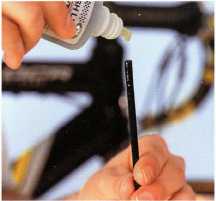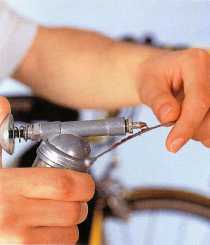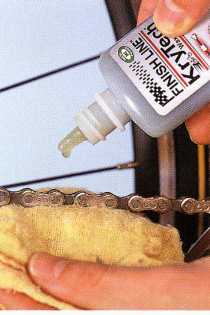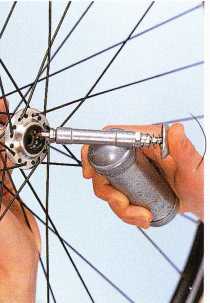Regular lubrication helps a bike to run smoothly and prevents excessive wear and tear. Each time a part of the bike is lubricated, remember to remove the old oil and grease with degreaser first . Applying new lubrication on top of old does not work because lubricants attract grit and dirt to the bike and form a grinding paste that can cause damage.
The lubricants needed vary from light spray oil (dry lube) and heavier oil (wet lube) to light grease manufactured specifically for bikes and anti-seize compounds.
Applying oil and grease

1. Dribble some light oil inside the cable housings
before you fit a new cable. This makes sure that the cable runs smoothly
inside. Poor gear-shifts are often due to cables running dry inside their
housings. The same is true of brakes that are hard to apply and slow
to return to the ready-to-use position.

2. Smear grease on all new cables and, occasionally,
on old ones. Place a blob of grease on the nipple end of the cable, then
pull the cable through your thumb and index finger before fitting it.
Wear mechanic’s disposable gloves.

3. Dribble light oil on to the pivots in the front
and rear derailleurs once a week. The jockey pulleys on the rear derailleur
also need some light oil where they rotate around the jockey pulley bolts.
Make sure you flush out any old oil with degreaser first.

4. Oil the chain after riding in wet weather, and
clean, dry, and lubricate when cleaning your bike. Except in winter,
or in bad conditions, use light oil from a spray can or bottle. Hold
a cloth underneath the chain to catch any excess oil.

5. Grease open bearings after regular cleaning with
a light grease specifically made for bikes. Bottom brackets and hubs
need most attention, but headsets need re-greasing less often. Riding
regularly in the rain shortens the interval between lubrications.

6. Spread anti-seize compound on the seat pin and
stem to prevent the two components from binding with the seat tube or
steerer tube. Although you can grease instead of anti-seize, always use
copper-based anti-seize compound for lubricating components made of carbon
fiber (fibre UK spelling).
We have two Lubricant Shops that feature every major, modern lubricant in the bicycle industry: